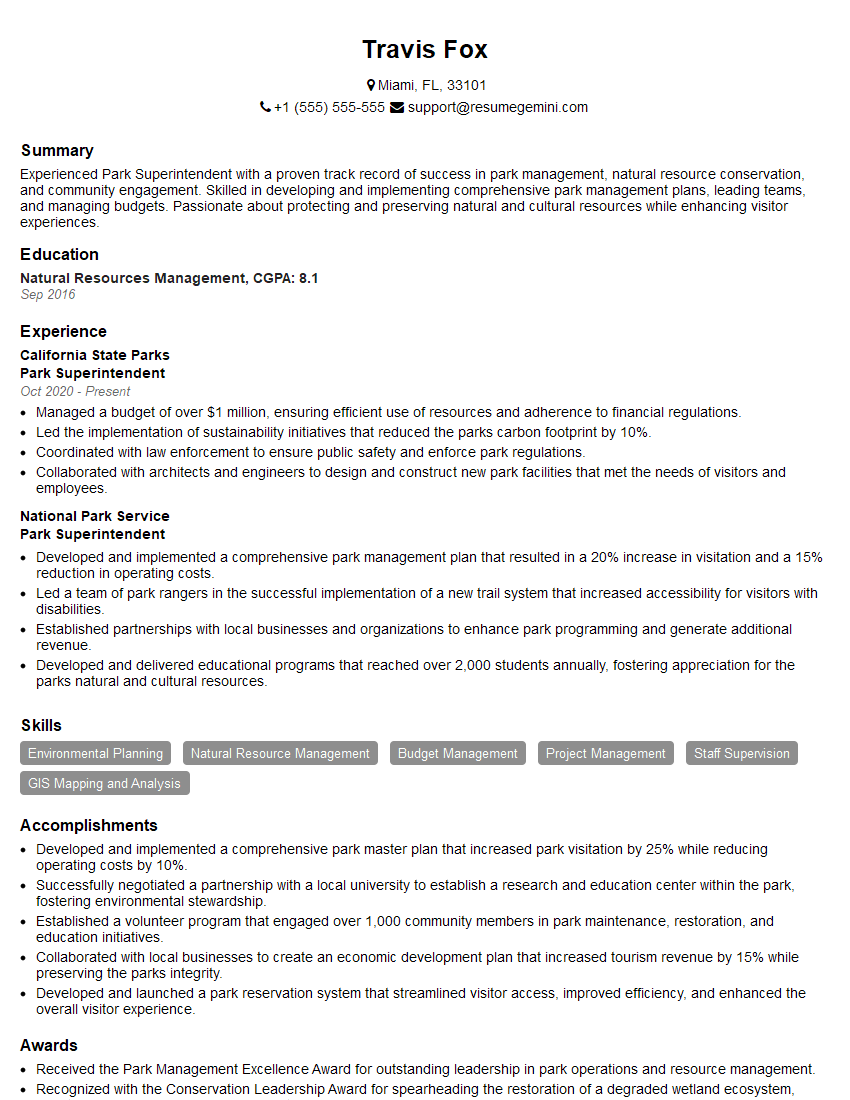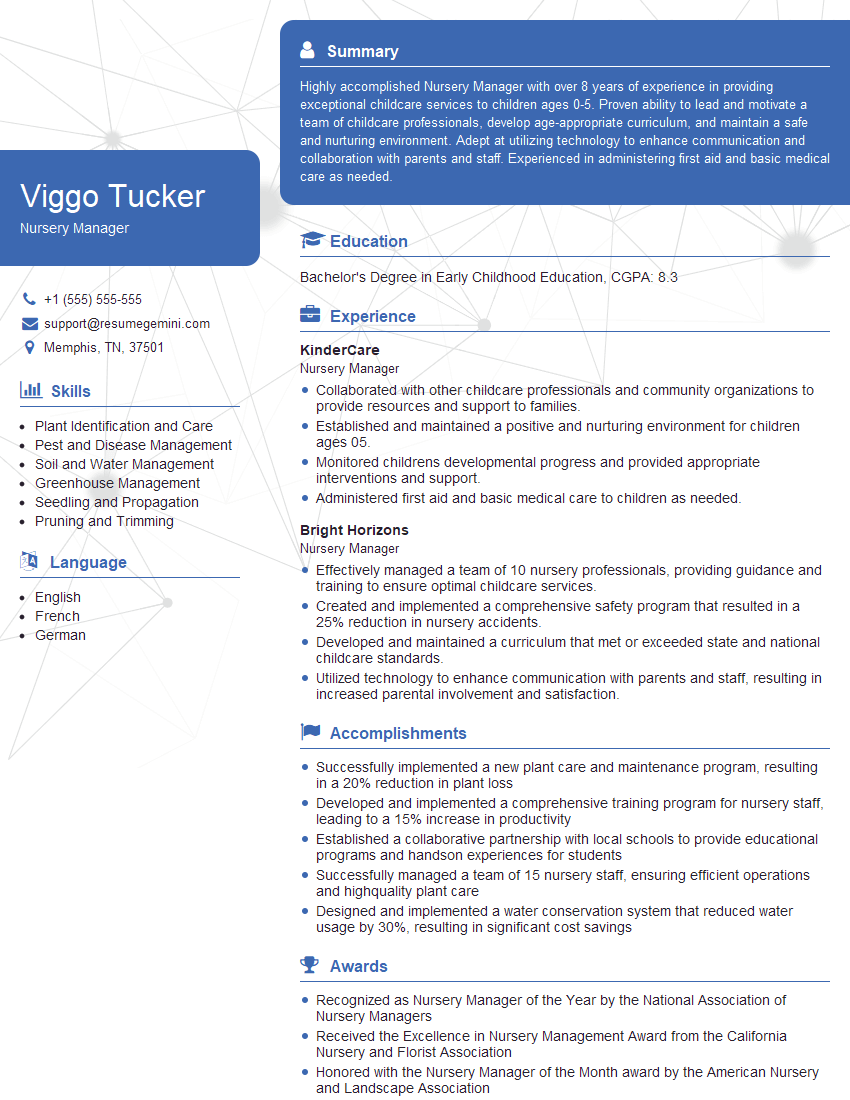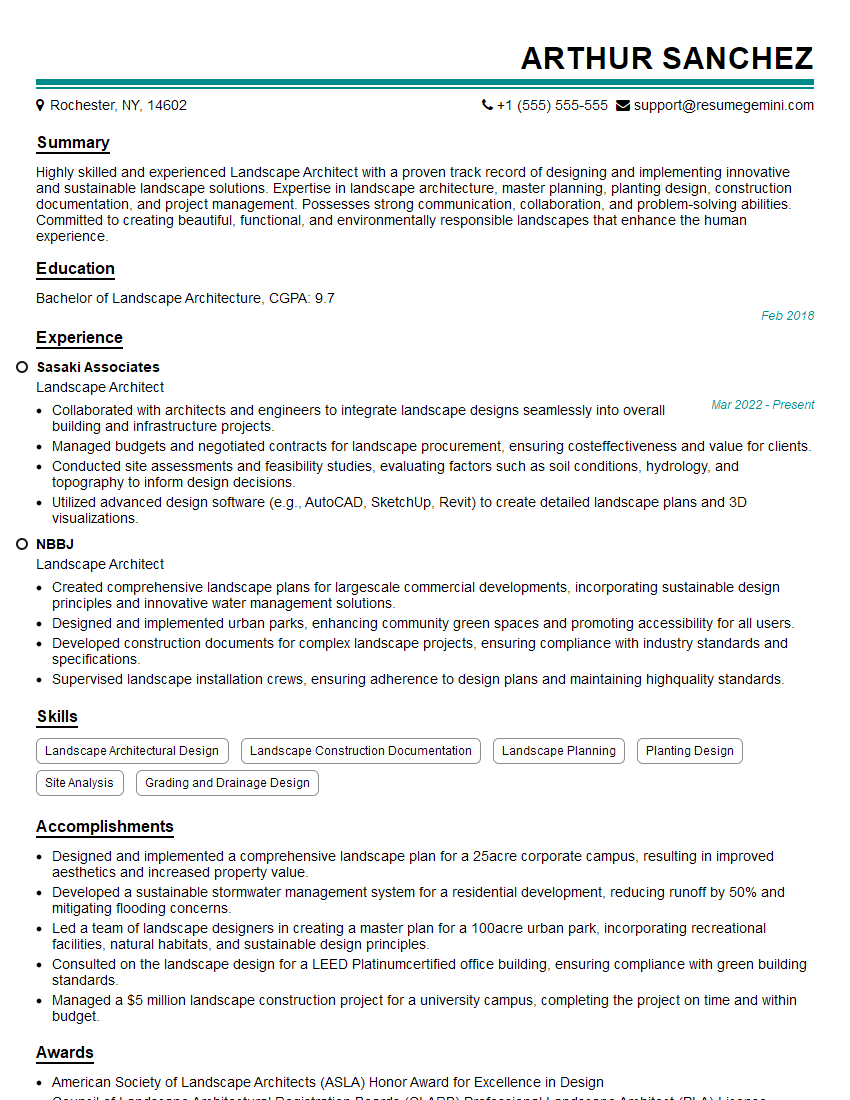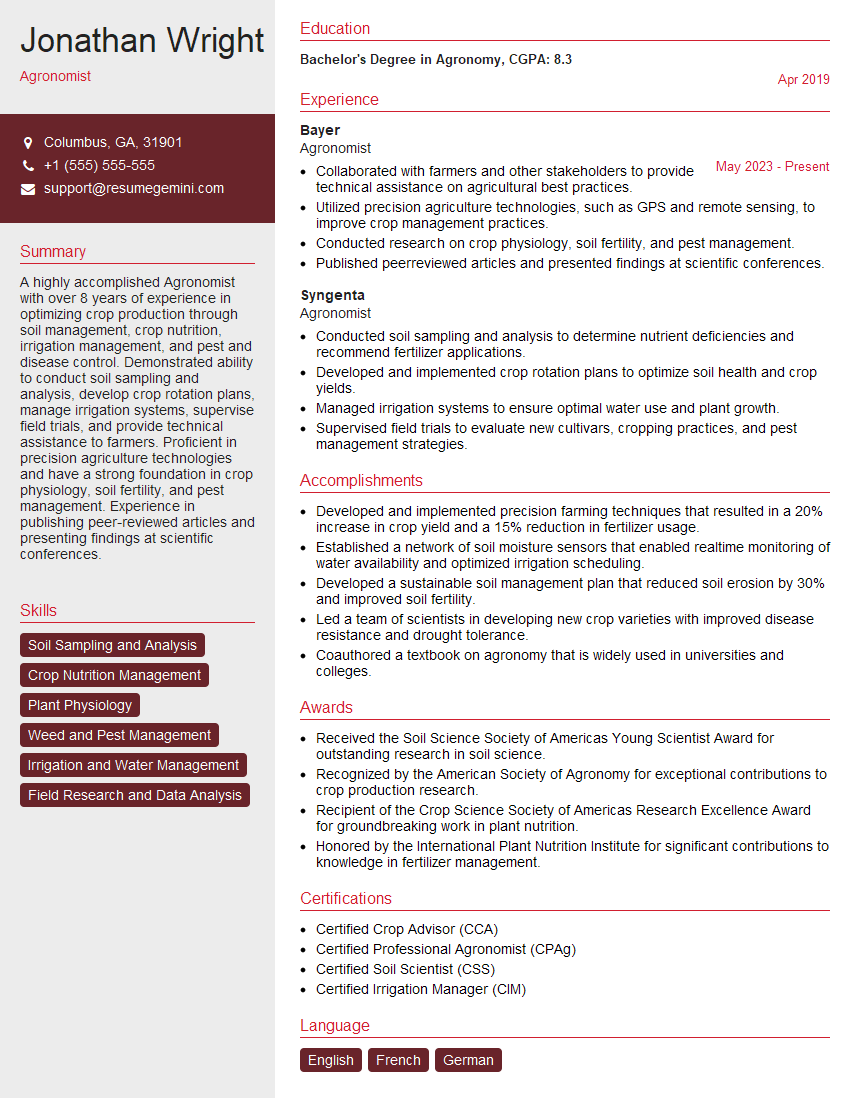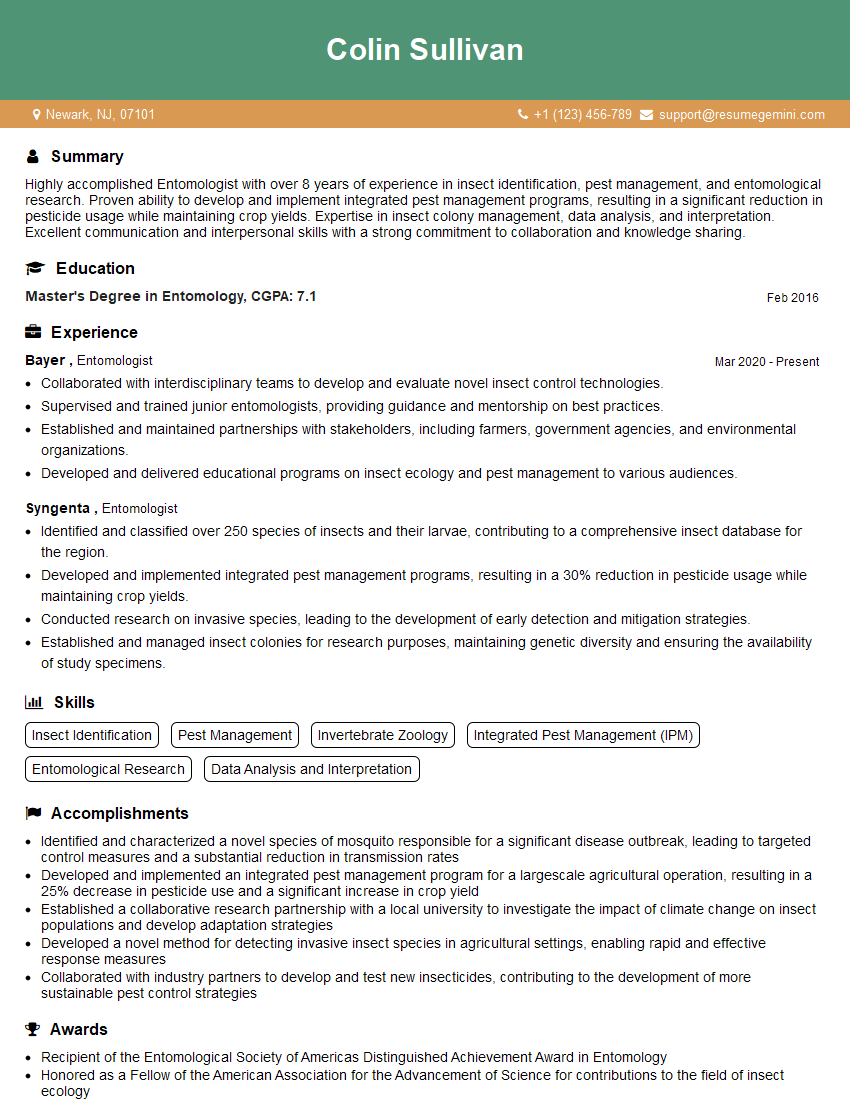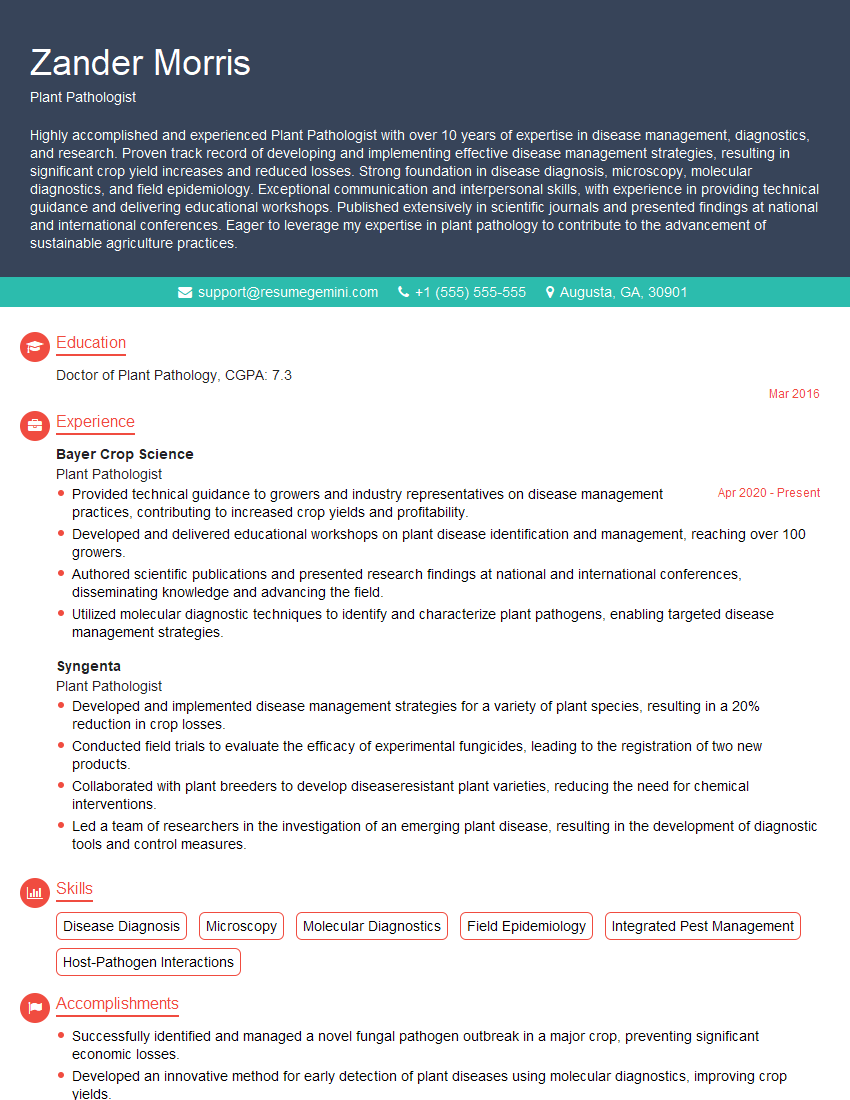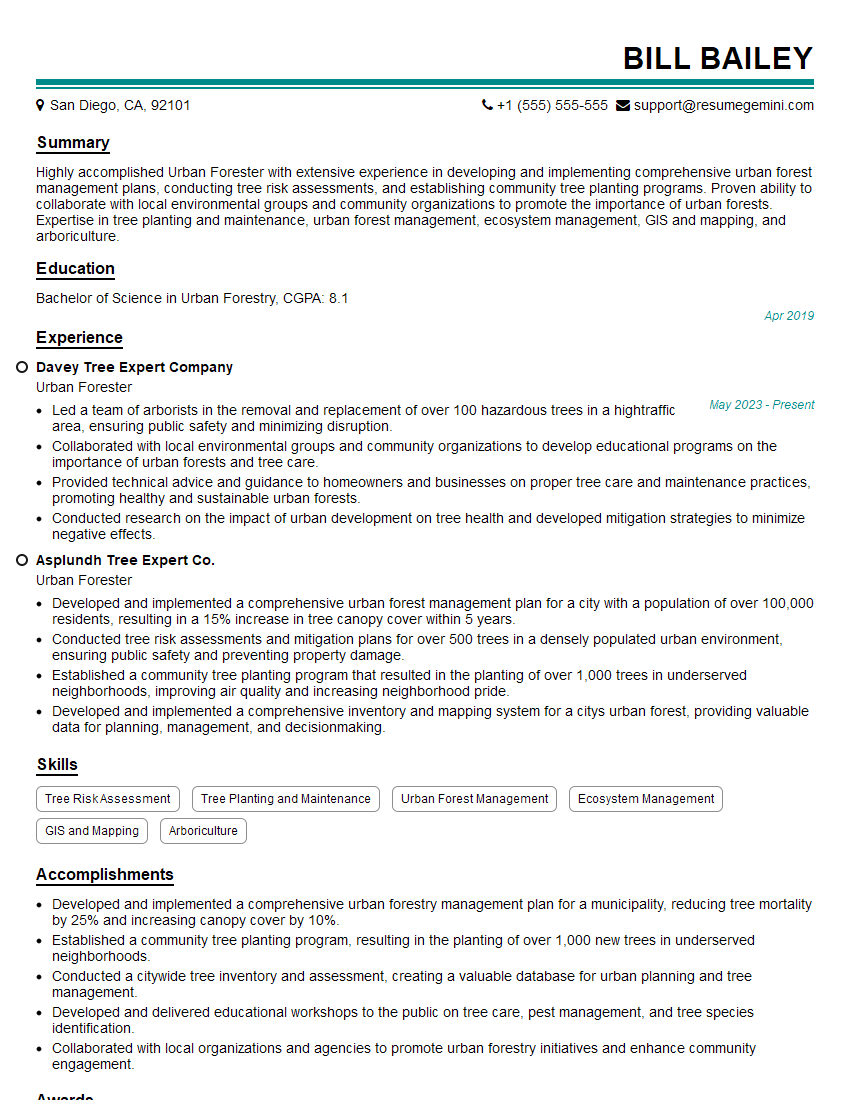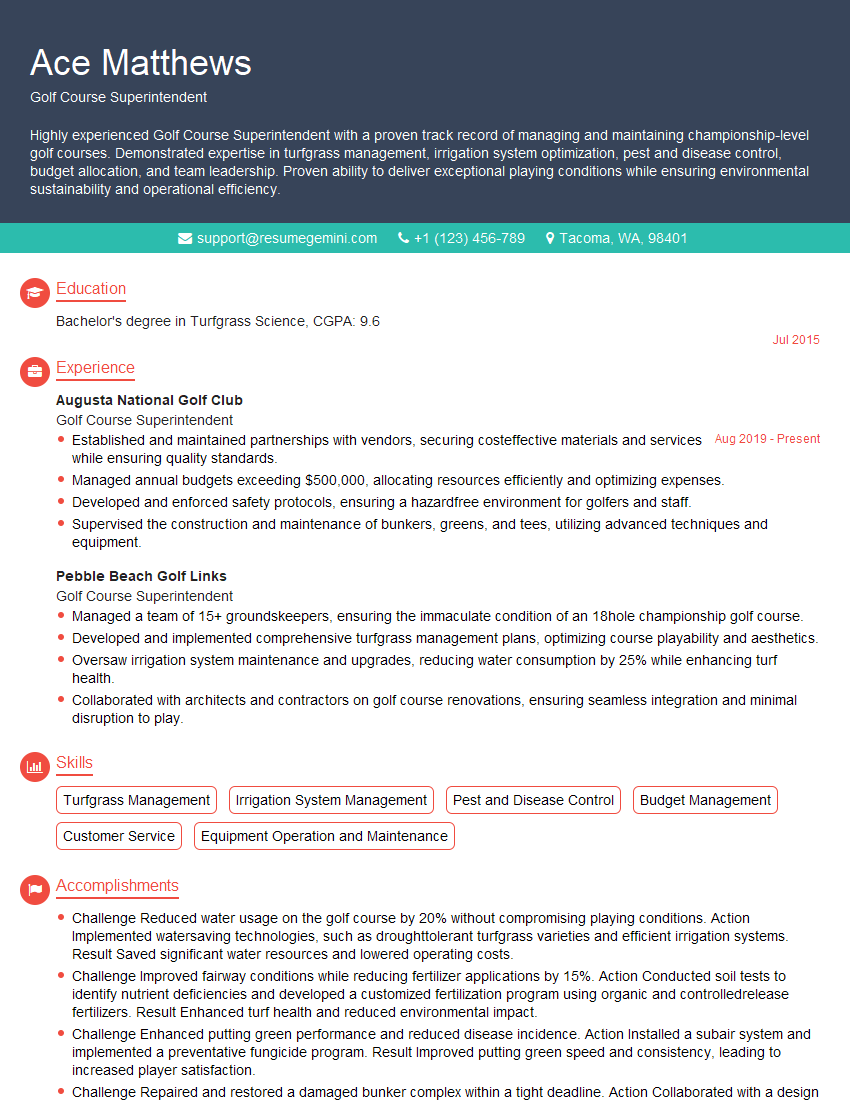Preparation is the key to success in any interview. In this post, we’ll explore crucial Turf and Plant Health Assessment interview questions and equip you with strategies to craft impactful answers. Whether you’re a beginner or a pro, these tips will elevate your preparation.
Questions Asked in Turf and Plant Health Assessment Interview
Q 1. Describe your experience diagnosing plant diseases.
Diagnosing plant diseases requires a systematic approach combining observation, knowledge, and sometimes laboratory testing. I begin by carefully examining the affected plants, noting symptoms like discoloration, lesions, wilting, or unusual growth patterns. The location of symptoms – on leaves, stems, roots – is crucial. For instance, leaf spots might suggest a fungal infection, while root rot points to a problem with soil drainage or a pathogen in the soil.
Next, I consider environmental factors. Was there a recent period of unusually wet or dry weather? Were there changes in fertilization or pesticide application? This information helps narrow down the possible causes. I then refer to diagnostic resources like plant disease guides and online databases to compare the observed symptoms with known diseases. Sometimes, it’s necessary to take samples to a laboratory for pathogen identification through microscopic examination or DNA testing. For example, I once diagnosed a severe case of dollar spot in a golf course by visually identifying the characteristic straw-colored lesions and confirming it with a lab test. Accurate diagnosis is key, as it dictates appropriate and effective treatment strategies, preventing further damage and saving resources.
Q 2. Explain the different types of turfgrass and their suitability for various climates.
Turfgrasses are categorized into different types based on their growth habits and climatic tolerances. Cool-season grasses thrive in cooler temperatures (60-75°F) and are best suited for northern climates or high-altitude regions. Popular examples include Kentucky bluegrass, fine fescue, and perennial ryegrass. These grasses often go dormant during hot summer months. Conversely, warm-season grasses prefer warmer temperatures (80-90°F) and are ideal for southern climates. Common examples are Bermuda grass, Zoysia grass, and St. Augustine grass. These grasses often go dormant in winter.
Selecting the right turfgrass is crucial. Using a cool-season grass in a hot, humid climate will lead to stress, disease, and poor performance. Similarly, planting a warm-season grass in a cold climate will result in thin, patchy turf. The choice should also consider factors like soil type, sun exposure, and the intended use of the turf area (e.g., a high-traffic sports field will need a more durable grass than a residential lawn).
Q 3. How do you identify and manage common turfgrass pests?
Identifying turfgrass pests involves careful observation. Common pests include insects like chinch bugs, grubs (white grubs), and sod webworms, as well as nematodes (microscopic worms). Visual inspection can reveal signs of infestation: discolored patches, dead areas, holes in the leaves, or the pests themselves. You can also employ techniques like the soapy water test to detect chinch bugs, which reveal themselves when the turf is flooded with soapy water.
Managing pests begins with correct identification. Integrated Pest Management (IPM) is a sustainable approach that involves monitoring pest populations, utilizing cultural controls (like proper mowing and fertilization to promote turf health), and applying pesticides only when necessary. Less toxic and targeted control methods are preferable, such as biological controls (introducing beneficial insects that prey on pests) or using insect growth regulators. Severe infestations may warrant the use of insecticides. The application method, timing and choice of pesticide should always be considered and aligned with the pest found and the environment. Proper record-keeping helps monitor the effectiveness of pest management strategies.
Q 4. What are the key factors to consider when developing a fertilization program for turf?
Developing a fertilization program involves understanding the needs of the specific turfgrass, soil conditions, and environmental factors. Soil testing is fundamental to determine the existing nutrient levels, pH, and organic matter content. This informs the type and amount of fertilizer needed.
Key factors include:
- Turfgrass Type: Different grasses have different nutrient requirements.
- Soil Test Results: This guides the fertilizer blend and application rate.
- Growth Rate: More frequent fertilization is needed during periods of rapid growth (spring and fall).
- Environmental Conditions: Factors like rainfall and temperature affect nutrient uptake.
- Traffic Levels: High-traffic areas may need more frequent fertilization to maintain turf density.
A well-balanced fertilization program considers the three primary macronutrients (Nitrogen, Phosphorus, and Potassium) as well as micronutrients. It’s best to apply fertilizer in split applications rather than one large application to prevent nutrient runoff and to ensure gradual and steady growth. Improper fertilization can cause environmental damage like eutrophication of water systems so precise planning is essential.
Q 5. Explain the importance of soil testing in turfgrass management.
Soil testing is paramount in turfgrass management because it provides a baseline understanding of the soil’s characteristics, including pH, nutrient levels (macro and micronutrients), organic matter content, and potential salinity. This information is critical for making informed decisions about fertilization, irrigation, and overall turfgrass health.
For instance, a soil test might reveal a deficiency in phosphorus, which is essential for root development. Knowing this allows for targeted fertilization with a phosphorus-rich fertilizer, improving root growth and overall turf health. Similarly, if the soil is too acidic or alkaline, it affects nutrient availability. Adjusting soil pH through liming (for acidic soils) or sulfur application (for alkaline soils) optimizes nutrient uptake. Soil testing helps avoid unnecessary fertilization, saving money and reducing the risk of environmental damage. In essence, soil testing provides a scientific foundation for developing effective and sustainable turfgrass management strategies.
Q 6. Describe different irrigation methods and their efficiency.
Several irrigation methods exist, each with varying efficiencies. Traditional sprinkler systems are widely used but can be inefficient due to water evaporation and runoff. Drip irrigation, on the other hand, delivers water directly to the root zone, minimizing water loss. This method is highly efficient and reduces water consumption significantly. Other techniques include subsurface irrigation, where water is applied beneath the soil surface, and rotor sprinklers which have a longer range.
Irrigation efficiency depends on factors like water pressure, nozzle type, and the uniformity of water distribution. Sensors and smart controllers can optimize irrigation schedules based on weather conditions and soil moisture levels, further increasing efficiency and conserving water. Choosing the most appropriate irrigation method depends on the size and type of turfgrass area, the available water resources, and the budget.
Q 7. How do you manage weed pressure in turfgrass areas?
Weed management in turfgrass involves a multi-pronged approach combining preventative and control measures. Prevention begins with proper turf maintenance: regular mowing at the correct height, proper fertilization to promote dense turf, and appropriate irrigation to avoid stress. A healthy turf creates a competitive environment that hinders weed establishment.
Control methods include cultural practices such as hand weeding (for small areas) and proper mowing techniques. Herbicides can be used for more extensive weed infestations, but their use must be carefully considered. Pre-emergent herbicides prevent weed seeds from germinating, while post-emergent herbicides control already established weeds. The choice of herbicide depends on the type of weed and the turfgrass species. It’s essential to follow herbicide label instructions carefully and to avoid over application. Integrated weed management, combining cultural practices and herbicides when necessary, is the most sustainable and effective approach to manage weed pressure.
Q 8. What are the best practices for overseeding turf?
Overseeding is the process of sowing new seed into an existing turfgrass stand to thicken it, improve its color, or introduce a different variety. Success hinges on proper timing, seed selection, and technique.
- Timing: The ideal time is in the fall (for cool-season grasses) or spring (for warm-season grasses), when temperatures are moderate and soil moisture is adequate. This allows the new seedlings to establish before the stresses of summer heat or winter cold.
- Seed Selection: Choose a grass species suited to your climate and soil conditions. Consider disease resistance and wear tolerance. For example, if you have a Kentucky bluegrass lawn struggling with drought, overseeding with a drought-tolerant fescue blend might be beneficial.
- Preparation: Scalping the existing turf to about 1/2 inch encourages seed-to-soil contact. Aerate the soil to improve drainage and allow seed to penetrate. A light topdressing of soil or compost can also aid germination and establishment.
- Seeding: Spread the seed evenly, using a spreader for larger areas to ensure consistent coverage. After seeding, lightly rake the seed into the soil and water gently to promote germination.
- Post-Seeding Care: Maintain consistent moisture to keep the seed bed moist but not waterlogged. Avoid heavy traffic until the seedlings are established. Fertilize lightly after germination to encourage growth.
For instance, I once helped a client revitalize a heavily shaded area of their lawn by overseeding with fine fescue. The existing turf was struggling, but the fescue thrived in the lower light conditions, leading to a dramatic improvement in the lawn’s density and appearance.
Q 9. How do you address thatch buildup in turf?
Thatch is a layer of dead and decaying organic matter that accumulates between the grass blades and the soil surface. While a thin layer of thatch can be beneficial, excessive buildup can suffocate the grass, reducing its vigor and increasing susceptibility to diseases and pests. Addressing thatch accumulation requires a multi-pronged approach.
- Regular Core Aeration: This is crucial for reducing compaction and improving air and water penetration, allowing thatch to decompose naturally. Core aeration removes plugs of soil, creating channels for air and water.
- Vertical Mowing (Dethatching): This uses a specialized mower with blades that cut vertically through the thatch layer, removing a significant portion of the accumulated organic matter. However, it is important not to over-dethatch, as it can damage the healthy turfgrass.
- Topdressing: Applying a thin layer of sand or compost helps to break down thatch and improve soil structure. The topdressing should be only a light layer; otherwise, it can smother the turf.
- Cultural Practices: Proper fertilization, mowing height adjustment (avoiding scalping), and watering practices are essential to prevent excessive thatch buildup. Avoid over-fertilizing with nitrogen, which stimulates excessive leaf growth that eventually contributes to thatch.
The best method depends on the severity of the thatch buildup. In cases of extreme thatch accumulation, a combination of techniques may be necessary. For example, I once managed a golf course with a severe thatch problem. We implemented a comprehensive program combining core aeration, vertical mowing, and topdressing, along with adjustments to fertilization and irrigation practices. This successfully reduced the thatch layer over several months.
Q 10. Explain the principles of integrated pest management (IPM).
Integrated Pest Management (IPM) is a sustainable approach to managing pests that prioritizes prevention and minimizes the use of pesticides. It emphasizes a holistic understanding of the ecosystem to minimize pest damage while preserving beneficial organisms and minimizing environmental impact. IPM relies on several key principles:
- Monitoring and Identification: Regularly inspecting turf for pests and diseases is crucial. Accurate identification of the pest or disease allows for targeted management strategies.
- Prevention: Implementing cultural practices to create an environment less favorable to pests is crucial. This includes proper fertilization, mowing, and watering, as well as selecting pest-resistant turfgrass varieties.
- Biological Control: Utilizing natural enemies of pests, such as beneficial insects or nematodes, can effectively control pest populations without resorting to synthetic pesticides.
- Mechanical Control: Physical methods like handpicking pests, mowing, or weeding can be effective for small infestations or specific situations.
- Chemical Control: Pesticides are used only as a last resort and only after careful consideration of their impact on the environment and non-target organisms. Targeted applications using the minimum effective dose are preferred.
For example, if I observe aphids on a client’s lawn, I’d first try to encourage beneficial insects like ladybugs that prey on aphids. Only if that isn’t sufficient would I consider a targeted insecticide application.
Q 11. Describe your experience with different types of herbicides and their application.
My experience encompasses a wide range of herbicides, from selective to non-selective, pre-emergent to post-emergent. Understanding their modes of action and application is crucial for effective and safe use.
- Pre-emergent Herbicides: These prevent weed seeds from germinating. Examples include dithiopyr and prodiamine, often used in the spring to control annual weeds. The timing of application is critical, as it needs to be applied before weed seeds germinate.
- Post-emergent Herbicides: These control existing weeds. Selective herbicides target specific weed types while sparing the desired turfgrass. Examples include 2,4-D, dicamba, and MCPA, used for broadleaf weed control in turf. Non-selective herbicides kill all vegetation, including the turfgrass. Glyphosate is a common example used for spot treatments of weeds or before renovation.
- Application Methods: Herbicides can be applied in various ways, including broadcast spraying (for large areas), spot spraying (for individual weeds), or granular application. Proper calibration of equipment is crucial for accurate application and to avoid herbicide drift. Always follow label instructions carefully, including personal protective equipment and environmental precautions.
I once used a combination of pre-emergent and post-emergent herbicides to effectively control a severe weed infestation in a large commercial property. This involved carefully selecting appropriate products, timing applications correctly, and using appropriate application equipment and techniques.
Q 12. How do you interpret soil test results and adjust management practices accordingly?
Soil tests provide invaluable information about the soil’s pH, nutrient levels, and organic matter content. This data is essential for making informed decisions about fertilization and other management practices.
- Interpreting Results: A soil test report will typically show the levels of essential nutrients (nitrogen, phosphorus, potassium), pH, and organic matter. Comparing these values to recommended ranges for your turfgrass species helps determine nutrient deficiencies or excesses. For example, a low pH might indicate a need for liming.
- Adjusting Management Practices: Based on the test results, I adjust fertilization recommendations. If the test indicates low phosphorus, a phosphorus-rich fertilizer is applied. If the pH is too low, lime is added to raise it. Similarly, high levels of a nutrient might indicate a need to reduce fertilizer applications to prevent buildup and potential environmental issues.
- Importance of Regular Testing: Soil conditions can change over time. I recommend regular soil testing (at least every 2-3 years) to monitor changes and adapt management practices accordingly.
I remember a case where a soil test revealed a significant potassium deficiency. This explained why the turf was showing signs of weakness and discoloration. After applying a potassium-rich fertilizer, the turf’s health and appearance significantly improved.
Q 13. What are the signs of nutrient deficiencies in plants?
Nutrient deficiencies manifest in various ways, often showing as discoloration or abnormalities in plant growth.
- Nitrogen (N) Deficiency: The plant exhibits general yellowing (chlorosis) starting from older leaves, stunted growth, and a thin, weak appearance.
- Phosphorus (P) Deficiency: Stunted growth, dark green or purplish discoloration on older leaves, and delayed maturity are common symptoms. Roots may be poorly developed.
- Potassium (K) Deficiency: Marginal leaf burn (brown tips and edges), leaf chlorosis, and weak stalks are typical signs. The plant becomes more susceptible to disease and drought stress.
- Other Deficiencies: Deficiencies in other micronutrients (iron, manganese, zinc, etc.) can present with distinct, often localized, symptoms such as interveinal chlorosis (yellowing between leaf veins) or necrotic spots.
Identifying the specific deficiency requires careful observation of the symptoms and, often, a tissue test to confirm the diagnosis. For example, I’ve seen interveinal chlorosis in plants indicating iron deficiency, which can be corrected by applying iron chelates. Visual symptoms alone aren’t always definitive; soil and tissue testing provides crucial confirmation.
Q 14. How do you manage compacted soil?
Compacted soil restricts root growth, reducing water and nutrient uptake, which can lead to weak, unhealthy turf. Managing compacted soil requires improving its structure and porosity.
- Core Aeration: Removing small cores of soil breaks up compaction, allowing air, water, and roots to penetrate more easily. This is one of the most effective methods for improving soil structure.
- Slitting: A less aggressive approach than core aeration, slitting creates narrow slits in the soil to reduce compaction. This is less disruptive than core aeration and is useful in sensitive areas.
- Topdressing: Applying a thin layer of organic matter, such as compost or sand, helps to improve soil structure and increase porosity. It can also amend the soil’s nutrient content.
- Soil Amendments: Incorporating organic materials like compost improves the soil’s water-holding capacity, structure, and nutrient content. Gypsum can help improve soil structure in clay soils.
I once worked on a heavily trafficked area with severely compacted soil. A combination of core aeration, topdressing with a sand-compost mix, and regular overseeding gradually improved the soil structure and turf health over several years. The key was a patient, long-term approach.
Q 15. What are the effects of drought stress on plants?
Drought stress significantly impacts plant health, primarily by limiting water availability for crucial physiological processes. Think of it like this: plants are like tiny sponges, constantly absorbing water to maintain their structure and carry out essential functions. When drought hits, this sponge starts to dry out.
Wilting: The most visible effect. As water pressure decreases, plants lose turgor pressure, causing leaves to droop and wilt.
Reduced Growth: Lack of water slows down cell division and elongation, resulting in stunted growth and smaller leaves.
Stomatal Closure: Plants close their stomata (tiny pores on leaves) to conserve water, reducing gas exchange and impacting photosynthesis, the process by which they make food.
Increased Susceptibility to Disease and Pests: Stressed plants are weaker and more vulnerable to diseases and pests, making them easier targets.
Leaf Scorching and Browning: Severe drought can lead to irreversible damage, causing leaves to brown and die.
For instance, during a prolonged dry spell, a lush green lawn might turn brown and crispy, exhibiting all the symptoms mentioned above. Effective irrigation strategies and drought-tolerant plant selection are crucial mitigation tactics.
Career Expert Tips:
- Ace those interviews! Prepare effectively by reviewing the Top 50 Most Common Interview Questions on ResumeGemini.
- Navigate your job search with confidence! Explore a wide range of Career Tips on ResumeGemini. Learn about common challenges and recommendations to overcome them.
- Craft the perfect resume! Master the Art of Resume Writing with ResumeGemini’s guide. Showcase your unique qualifications and achievements effectively.
- Don’t miss out on holiday savings! Build your dream resume with ResumeGemini’s ATS optimized templates.
Q 16. How do you address salinity issues in turfgrass?
Salinity issues in turfgrass, caused by high salt concentrations in the soil, hinder water uptake and nutrient absorption, impacting overall health and vigor. It’s like trying to drink seawater – it’s salty and dehydrating. Managing salinity requires a multi-pronged approach:
Improved Drainage: Well-drained soil reduces salt accumulation. Techniques include aeration, grading, and installing drainage systems.
Soil Amendments: Adding organic matter like compost can improve soil structure and cation exchange capacity, helping bind and reduce the availability of sodium ions.
Flushing with Water: Applying copious amounts of good quality water (low salinity) can leach out accumulated salts from the root zone. Think of it as washing away the salt.
Salt-Tolerant Turfgrass Selection: Choosing turfgrass cultivars specifically bred for saline conditions is crucial for long-term success. Certain grasses are naturally more resistant than others.
Careful Fertilizer Management: Avoid using fertilizers high in sodium or chloride, which exacerbate salinity problems.
For example, in coastal regions with high salinity, using a salt-tolerant grass like seashore paspalum might be beneficial. Regular soil testing to monitor salt levels is also crucial for informed decision-making.
Q 17. What are your experience with various mowing techniques and their impact on turf health?
Mowing techniques significantly influence turfgrass health and appearance. Different techniques cater to various grass types and desired aesthetic outcomes. Think of it like getting a haircut – a bad cut can ruin your look, while a skilled barber enhances it.
Height of Cut: Maintaining the appropriate height of cut is crucial. Cutting too short stresses the grass, increasing susceptibility to diseases and weeds, while cutting too high can lead to thatch buildup.
Frequency of Mowing: More frequent, shorter cuts promote denser turf, but too frequent mowing can weaken the grass. A balance is key.
Sharp Blades: Dull mower blades tear grass leaves, creating ragged edges that are more vulnerable to diseases and stress. Sharp blades provide clean cuts that promote better health.
Mowing Pattern: Varying mowing patterns prevents soil compaction and promotes even growth.
Mulching Mowers: These mowers finely chop the grass clippings and return them to the lawn as a natural fertilizer, reducing the need for chemical fertilizers and improving soil health.
For example, in a high-traffic area, a slightly higher cut might be preferred to ensure turf resilience, while a more frequent mowing schedule could be suitable for a show lawn.
Q 18. Explain your understanding of plant physiology.
Plant physiology is the study of how plants function. It’s like understanding the inner workings of a complex machine, revealing how plants absorb water and nutrients, conduct photosynthesis, grow, reproduce, and respond to their environment. Key areas include:
Photosynthesis: The process by which plants convert light energy into chemical energy (sugars) using water and carbon dioxide.
Respiration: The process of breaking down sugars to release energy for growth and other functions.
Transpiration: The movement of water through the plant and its evaporation from leaves, crucial for nutrient transport and cooling.
Nutrient Uptake and Transport: How plants acquire essential nutrients from the soil and distribute them throughout their tissues.
Growth and Development: The processes that govern plant size, shape, and reproductive capabilities.
Stress Response: How plants react to environmental challenges like drought, salinity, and disease.
Understanding plant physiology allows us to diagnose plant problems more effectively and develop strategies for optimizing growth and health.
Q 19. Describe your experience with using diagnostic tools for plant health assessment.
I have extensive experience using various diagnostic tools for assessing plant health. These tools provide objective data beyond visual observations, helping make informed management decisions. It’s like having a sophisticated medical toolkit for plants.
Soil Testing: Analyzing soil samples for nutrient levels, pH, salinity, and organic matter content helps determine soil health and nutrient deficiencies.
Plant Tissue Analysis: Testing plant tissue samples for nutrient levels helps identify deficiencies or toxicities that may be impacting plant health.
Disease Diagnostics: Using microscopy and molecular techniques to identify specific plant pathogens (bacteria, fungi, viruses) that are causing disease.
Remote Sensing: Utilizing technologies like drones equipped with multispectral cameras to assess large areas of turfgrass for stress, disease, or other issues.
Water Testing: Analyzing water quality to identify potential issues like high salinity or contamination that could negatively affect turfgrass health.
For example, I once used plant tissue analysis to diagnose a micronutrient deficiency in a golf course, leading to targeted fertilization and improved turf quality.
Q 20. How do you manage turfgrass diseases using cultural practices?
Managing turfgrass diseases through cultural practices is a proactive and environmentally friendly approach. It’s about creating an environment where disease is less likely to thrive. Think of it like creating a healthy immune system for your lawn.
Proper Mowing Practices: Maintaining a healthy height of cut and using sharp blades minimizes stress and allows for better air circulation, reducing the risk of disease.
Appropriate Irrigation: Providing adequate, but not excessive, irrigation minimizes stress and reduces the risk of fungal diseases that thrive in wet conditions.
Fertilization: Proper fertilization promotes vigorous plant growth, increasing resistance to disease. Avoid excessive nitrogen, which can stimulate excessive growth and increase susceptibility to some pathogens.
Thatch Management: Reducing thatch buildup improves air and water movement, preventing disease development.
Soil Aeration: Improves root growth and gas exchange, enhancing disease resistance.
Sanitation: Removing infected plant debris and avoiding spreading diseased plant material helps prevent disease spread.
For instance, regularly removing leaf debris in autumn significantly reduces the chances of fungal leaf spot diseases in the following spring.
Q 21. What are the environmental impacts of turfgrass management?
Turfgrass management, if not done sustainably, can have significant environmental impacts. It’s important to consider the wider ecological context of our practices.
Water Consumption: Irrigation can consume large amounts of water, especially in arid and semi-arid regions. Water-wise irrigation practices and drought-tolerant turfgrass selection are crucial.
Pesticide and Fertilizer Use: Excessive use of pesticides and fertilizers can contaminate soil and water, harming beneficial organisms and potentially impacting human health. Integrated pest management (IPM) strategies should be adopted.
Greenhouse Gas Emissions: Mowing equipment uses fossil fuels, contributing to greenhouse gas emissions. Using electric or alternative fuel mowers can lessen this impact.
Habitat Loss: Large areas of turfgrass can reduce biodiversity by displacing native plant communities. Incorporating native plants within turf landscapes can support a wider range of species.
Soil Compaction: Heavy equipment use can compact the soil, reducing air and water infiltration. Careful management practices can minimize this impact.
Sustainable turfgrass management prioritizes resource conservation, minimizing environmental impact, and maximizing ecosystem health.
Q 22. Describe your experience with different types of pesticides and their safety considerations.
My experience encompasses a wide range of pesticides, from traditional chemical controls to newer, more environmentally friendly options like biological controls and plant-based extracts. Safety is paramount. Before using any pesticide, I always meticulously review the label, ensuring I understand the active ingredients, application rates, personal protective equipment (PPE) requirements, and potential environmental impacts. For example, when working with systemic insecticides, I emphasize meticulous application to minimize drift and protect non-target organisms. With herbicides, I carefully select products based on the specific weed species and the turfgrass type, opting for selective herbicides whenever possible to avoid damage to the desirable turf. PPE use is non-negotiable, including gloves, eye protection, respirators (when necessary), and protective clothing. I also always follow local regulations and best management practices (BMPs) to ensure both human and environmental safety. For instance, I would never apply pesticides near water bodies or during windy conditions. Proper disposal of empty pesticide containers is also crucial and is done following all regulatory guidelines. I firmly believe in a preventative approach, minimizing pesticide use by prioritizing cultural practices that improve turfgrass health and resilience.
Q 23. How do you create a sustainable turfgrass management plan?
A sustainable turfgrass management plan prioritizes environmental stewardship and long-term health, minimizing resource inputs while achieving desired turf quality. It begins with a thorough site assessment, identifying soil type, sunlight exposure, and existing turfgrass species. This informs the selection of appropriate grass varieties – drought-tolerant, disease-resistant species are favored. Next, I focus on cultural practices: proper fertilization (using slow-release fertilizers to minimize nutrient runoff), appropriate irrigation (efficient watering schedules that avoid overwatering), and regular mowing at the correct height (encouraging deep root growth). Aerification and topdressing improve soil health and water penetration. Integrated Pest Management (IPM) is crucial, prioritizing preventative measures (like proper fertilization) before resorting to chemical controls. This might involve introducing beneficial nematodes to control certain pests or using disease-resistant turf cultivars. Regular monitoring is vital, using soil tests to guide fertilization and visual inspections to detect potential problems early. Data collection helps refine the plan over time, making it more efficient and effective. Imagine a golf course – a sustainable plan would combine strategic mowing and careful fertilization with minimal pesticide application, resulting in a healthy course that requires less maintenance in the long run and reduces the environmental impact.
Q 24. What are the challenges of maintaining turfgrass in urban environments?
Maintaining turfgrass in urban environments presents unique challenges. High foot traffic often leads to compaction and soil erosion, weakening the turf. Limited space restricts aeration and other cultural practices. Pollution from vehicular traffic and industrial sources can contaminate soil and water, impacting turfgrass health. Shade from buildings and trees can create uneven growth. The urban heat island effect increases water stress, requiring more frequent irrigation. Dog waste and litter significantly affect turfgrass health, introducing pathogens and nutrients that harm the plant. Furthermore, limited access to sunlight in densely built areas can also severely restrict the suitable turf species available. The high costs of water in some urban environments can further restrict options for management.
Q 25. How do you communicate plant health issues to clients or supervisors?
Clear and concise communication is vital. I begin by accurately identifying the plant health issue, using precise terminology but avoiding excessive jargon. I provide a thorough explanation of the problem’s cause – for example, explaining how poor drainage led to root rot or how insect infestation caused damage. I then outline potential solutions, including suggested treatments (chemical or cultural), their costs, and expected timelines. Visual aids like photographs or soil test results can greatly enhance understanding. I always tailor my communication style to the audience; a technical report for a supervisor would differ from a simplified explanation for a homeowner. For example, a homeowner might not need to know about specific fungal pathogens, but they would need to understand the steps to improve drainage and the need to remove dead foliage to prevent the problem from recurring. Transparency regarding the limitations of certain treatments is also crucial to foster trust and realistic expectations.
Q 26. Describe your experience with turfgrass renovation projects.
My experience with turfgrass renovation projects spans a variety of situations, from small residential lawns to larger commercial areas. Successful renovation requires a systematic approach. First, I assess the existing conditions, identifying the cause of the poor turf (compaction, disease, poor drainage). Then, I determine the best course of action. This may involve dethatching, aerating, and overseeding existing turf or a complete removal and re-establishment of a new turf. The selection of appropriate grass species is a critical aspect that takes into account soil type, light conditions and the intended use of the area. Site preparation, including grading and amending the soil (if necessary), is equally important. Post-installation care includes proper watering, fertilization, and pest control to ensure the new turf establishes and thrives. For example, in a heavily compacted area, deep aeration is crucial before overseeding. A monitoring schedule is created and implemented to ensure success. For larger projects, detailed plans and timelines are crucial, including specifying the types of equipment and materials needed.
Q 27. How do you prioritize tasks in a high-pressure environment?
In high-pressure situations, prioritizing tasks involves a structured approach. I use a combination of techniques, including prioritizing by urgency and importance (using a matrix), and scheduling tasks using tools like project management software. For example, urgent and important tasks, like addressing a sudden disease outbreak or repairing immediate damage after a storm, take priority. Less urgent tasks might be scheduled for later. Delegation of tasks, where appropriate, helps free up time to focus on critical aspects. Effective communication with team members is also critical, ensuring everyone is aware of priorities and timelines. Regular review of the task list and adaptation to unexpected events are crucial for effective management. For instance, if a sudden unexpected rainfall delays aeration, I’d reschedule that task and adjust other related tasks to compensate.
Q 28. What software or tools are you proficient with related to turfgrass management?
I’m proficient in several software and tools relevant to turfgrass management. I regularly use Geographic Information Systems (GIS) software for site mapping and analysis, allowing for precise measurement and planning of projects. I utilize various project management tools for scheduling, tracking tasks, and resource allocation. Spreadsheet software is crucial for data management, tracking soil test results, fertilizer applications, and pest control interventions. Specific software for irrigation management is also helpful, allowing for precise scheduling and optimization of water usage. In addition to software, I’m adept at using various hand-held devices such as soil moisture meters, GPS units, and disease diagnostic tools, and specialized equipment such as aerators, and overseeders.
Key Topics to Learn for Turf and Plant Health Assessment Interview
- Soil Science Fundamentals: Understanding soil composition, pH levels, nutrient content, and their impact on turf and plant health. Practical application: Diagnosing nutrient deficiencies based on visual symptoms and soil testing results.
- Plant Pathology: Identifying common turf and plant diseases, understanding disease cycles, and implementing appropriate management strategies. Practical application: Differentiating between biotic and abiotic diseases and recommending effective control measures.
- Turfgrass Management: Mowing techniques, fertilization strategies, irrigation practices, and pest control methods. Practical application: Developing a comprehensive turf management plan based on site-specific conditions and goals.
- Weed Identification and Control: Recognizing common weeds in turf and landscape settings, understanding their biology, and applying appropriate control measures. Practical application: Selecting herbicides and implementing integrated weed management strategies.
- Integrated Pest Management (IPM): Implementing environmentally responsible pest control strategies that minimize pesticide use. Practical application: Developing and implementing an IPM plan for a specific turf or landscape area.
- Diagnostic Techniques: Utilizing various diagnostic tools and techniques to assess turf and plant health, including visual inspection, soil testing, and tissue analysis. Practical application: Interpreting diagnostic data to accurately identify problems and recommend solutions.
- Sustainable Practices: Incorporating sustainable practices into turf and plant health management, such as water conservation, reduced pesticide use, and organic approaches. Practical application: Designing and implementing a sustainable turf management program.
Next Steps
Mastering Turf and Plant Health Assessment is crucial for career advancement in the green industry, opening doors to specialized roles and higher earning potential. A strong resume is your key to unlocking these opportunities. Creating an ATS-friendly resume is essential for getting your application noticed by employers. To build a compelling and effective resume that showcases your skills and experience, leverage the power of ResumeGemini. ResumeGemini offers a user-friendly platform and provides examples of resumes tailored specifically to Turf and Plant Health Assessment, helping you stand out from the competition and land your dream job.
Explore more articles
Users Rating of Our Blogs
Share Your Experience
We value your feedback! Please rate our content and share your thoughts (optional).
What Readers Say About Our Blog
Hello,
We found issues with your domain’s email setup that may be sending your messages to spam or blocking them completely. InboxShield Mini shows you how to fix it in minutes — no tech skills required.
Scan your domain now for details: https://inboxshield-mini.com/
— Adam @ InboxShield Mini
Reply STOP to unsubscribe
Hi, are you owner of interviewgemini.com? What if I told you I could help you find extra time in your schedule, reconnect with leads you didn’t even realize you missed, and bring in more “I want to work with you” conversations, without increasing your ad spend or hiring a full-time employee?
All with a flexible, budget-friendly service that could easily pay for itself. Sounds good?
Would it be nice to jump on a quick 10-minute call so I can show you exactly how we make this work?
Best,
Hapei
Marketing Director
Hey, I know you’re the owner of interviewgemini.com. I’ll be quick.
Fundraising for your business is tough and time-consuming. We make it easier by guaranteeing two private investor meetings each month, for six months. No demos, no pitch events – just direct introductions to active investors matched to your startup.
If youR17;re raising, this could help you build real momentum. Want me to send more info?
Hi, I represent an SEO company that specialises in getting you AI citations and higher rankings on Google. I’d like to offer you a 100% free SEO audit for your website. Would you be interested?
Hi, I represent an SEO company that specialises in getting you AI citations and higher rankings on Google. I’d like to offer you a 100% free SEO audit for your website. Would you be interested?
good
